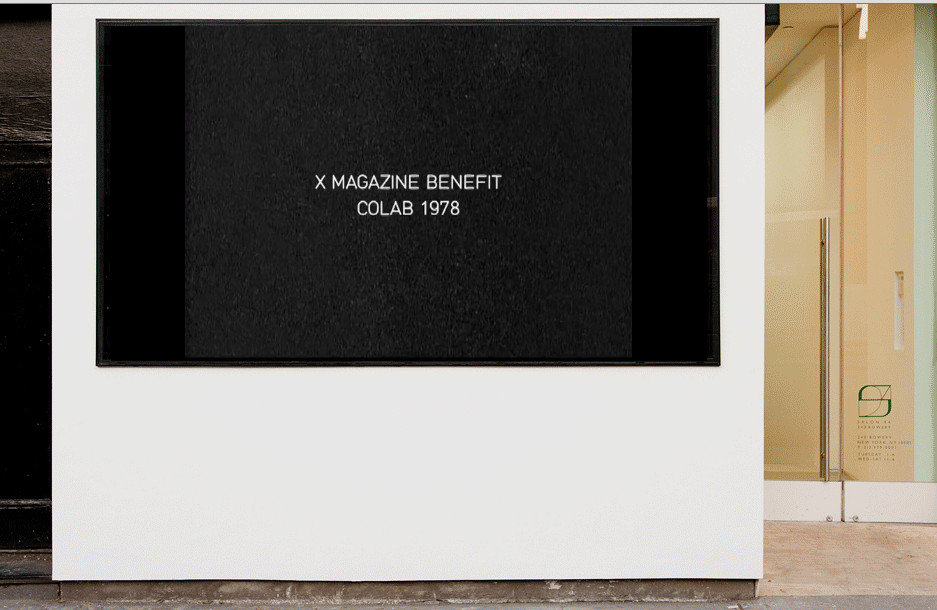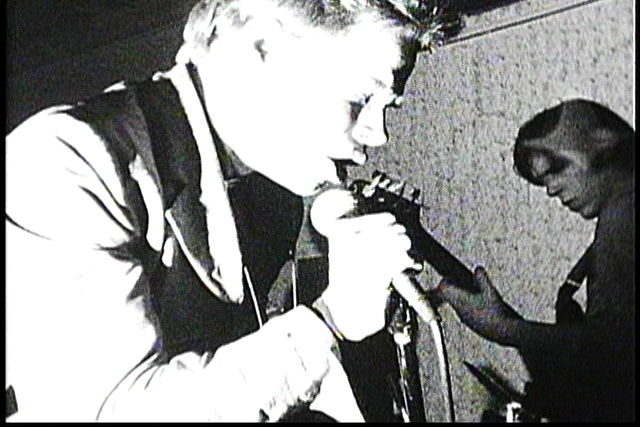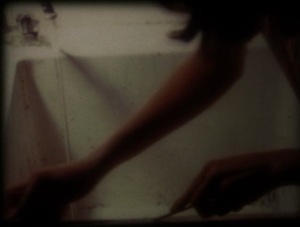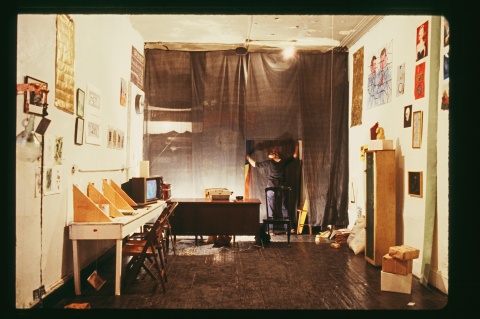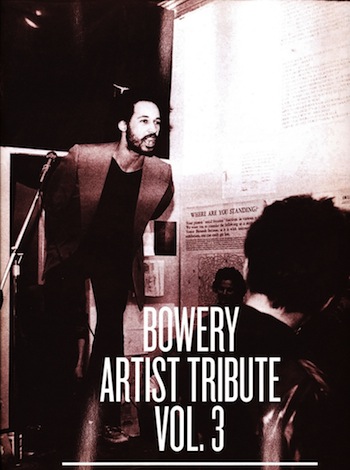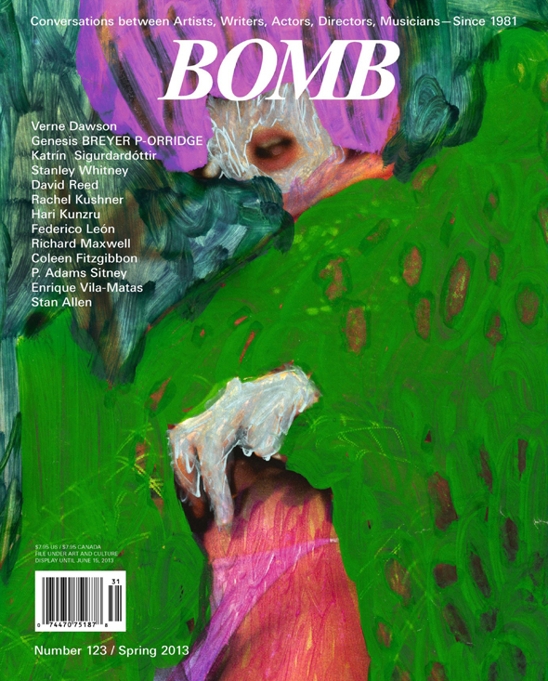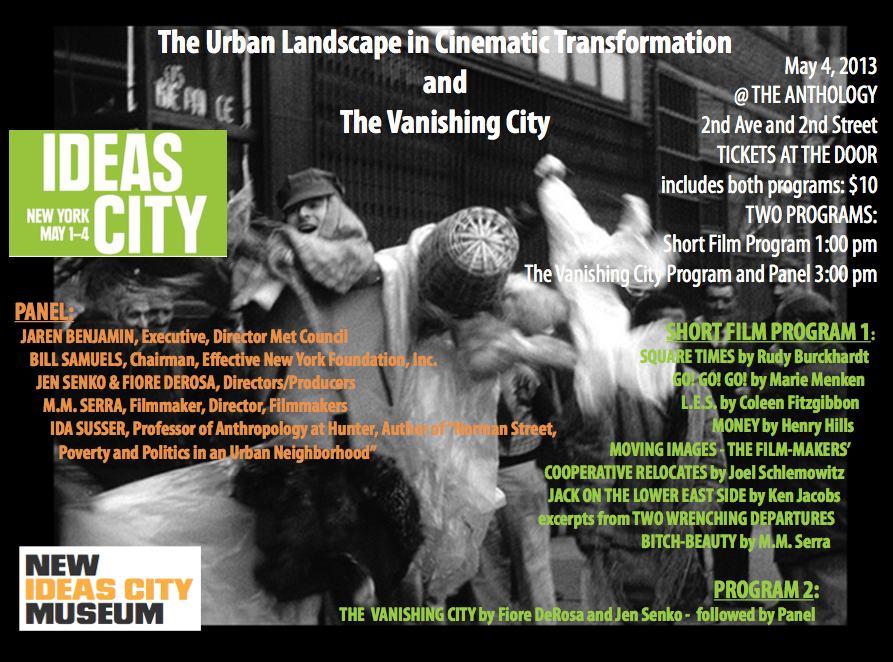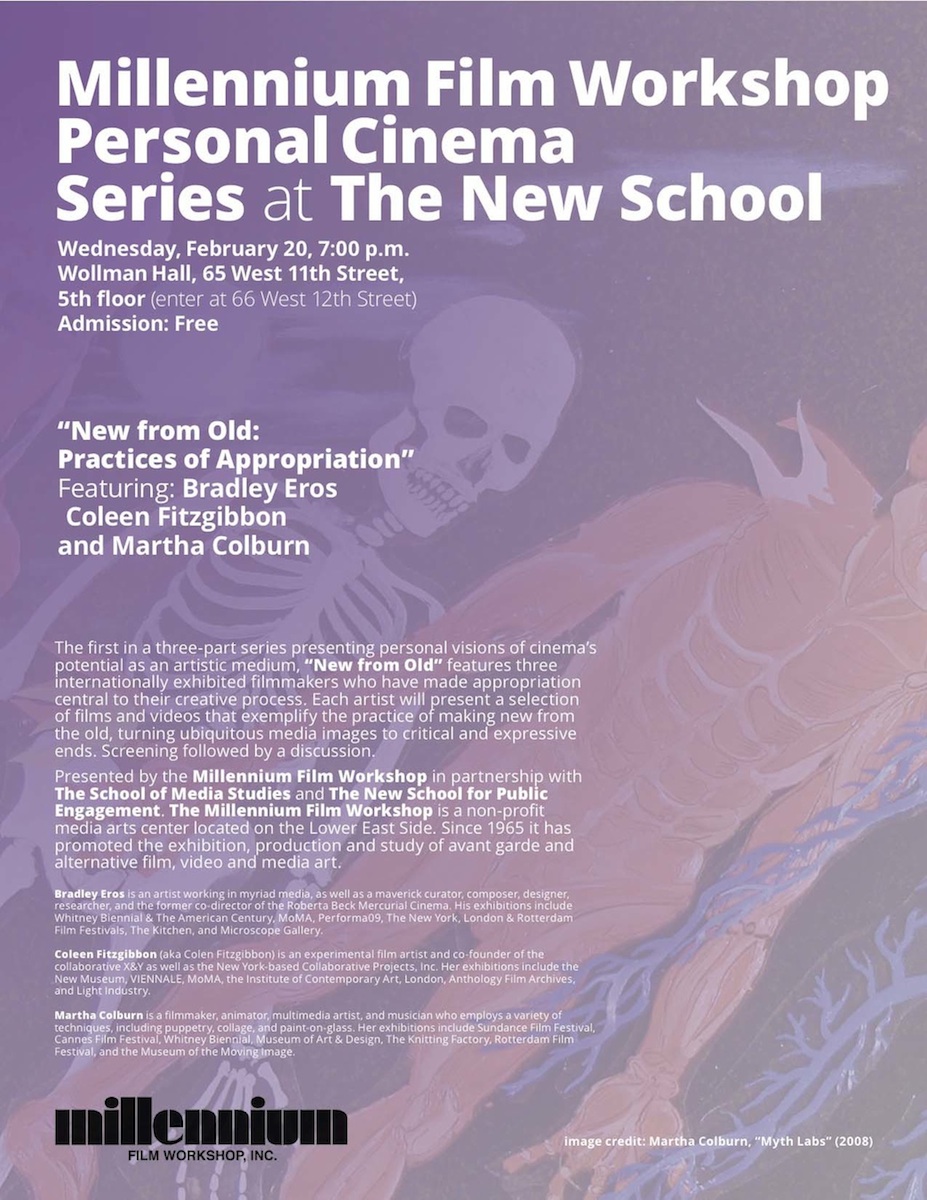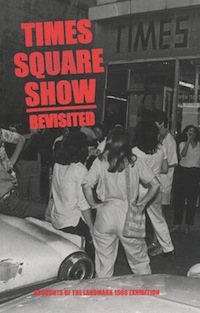
Cooper, Shawna and Karli Wurzelbacher, ed., Times Square Show Revisited: Accounts of the Landmark 1980 Exhibition. Hunter College. (NYC, 2011-12) 32-34
In the beginning Colab started as open, impromptu meetings in lower Manhattan sometime in November or December of 1977. They were publicized via word of mouth and held in artists’ studios with up to forty people. I use the word “we” to refer to Colab activities that I was part of. We were new to New York, equally divided between women and men, hanging out in pubs and clubs and starting to make art together. Almost everybody lived downtown, and there were a lot of artists in their twenties wanting to make art in a group or getting a group to help get their art made. We knew about the Judson Dance performances, Fluxus, Oldenburg’s Store, the Fox meetings and Fox zines, Semiotext(e), Happenings, Carolee Schneeman’s Meat Joy, the Film Co-op, the European AA Komune and other artists’ groups. Starting in the late sixties and early seventies, many of us had lived in or visited hippie communes, hitchhiked across the country or the world, taken part in urban squat movements and engaged in mass anti–Vietnam War rallies and music festivals. Collaboration was still in the air even if the Summer of Love was over.
The active life of Colab was from late 1977 to the mid-eighties, depending on who’s talking. The largest, most widely publicized show was theTimes Square Show in 1980, which was underwritten and paid for completely by Colab and its members. From its inception Colab morphed into two to three waves of artists coming and going. A lot of people that ended up in Colab weren’t there at the beginning; I was there for the first meeting and lasted until about 1982. Most members eventually burned out from argument abrasion. Colab went into permanent hiatus by 1986, with the exception of Alan Moore’s MWF [Monday, Wednesday, Friday] Club, which distributed past Colab videos of All Color News andPotato Wolf (and some other artist groups) into the nineties. Colab now has a Wiki archival site that viewers can visit but only the original Colab members can contribute to, and has also had a few shows recently that included historical relics.
Colab artists were a diverse group of forty to sixty artists, filmmakers, actors, and writers who were concerned with conceptual ideas and the political figurative in art, and whose agenda was to make exhibitions that encompassed art, film and video, magazines, theater and performances, live-cable TV shows, and political actions as a group. No curators and no critics. That was an early rule to try to keep artists from being influenced by the established intelligentsia, though a few slipped in, such as Liza Bear, Alan Moore, and Walter Robinson, all of whom also made art and temporarily dropped their official critical positions. Colab was set up by its “members” to support projects initiated by two or more Colab members (technically members were anyone who came to three consecutive meetings). Once Colab was incorporated and received grants it was able to support several projects (fully or partially) such as the Real Estate Show and ABC No Rio, the Times Square Show, New Cinema, Nightshift Theater, X Magazine (second and third issues), All Color News, Potato Wolf and Red Curtain cable TV shows,Spanner Magazine, Fashion Moda, the first Bomb Magazine issue, Tellus, A. Moore Store, and others. Before the grants, group activities were paid for by the artists themselves, who pooled their money and energies.
The galleries weren’t showing younger artists because there was no money in doing so. There was a recession in the US. Everything in New York was sort of in shambles: abandoned buildings, blackouts, no jobs; this was a key incentive for doing our own shows. At that point I remember going with a friend and neighbor, Betsy Sussler, to probably around the third, big, un-named meeting I attended. Betsy, Eric Mitchell, Michael McClard and maybe a few other people had just made one issue of a very small film-zine called X Motion Picture Magazine. I remember Betsy and Michael holding up this tiny newsprint rag, and going, “We made this as a group, this is the kind of thing we could do, we could do shows and magazines and whatever we want to.” So everybody went, “yeah, what a great idea, let’s do it.”
X was one of the catalysts for us to become a group and we published the second issue in February of 1978. On the cover was a man with two crossed swords (Michael submitted the image, which was apt, considering all of the internal debate it took to get that issue made). It was called a double issue since there were so many artists contributing. We each put in money for our pages (maybe it was ten to twenty dollars per page), did all the layout ourselves, and took it to the printers late at night for a reduced price. Steve Mass, who would later start the Mudd Club with Diego [Cortez], helped us take the copies to the downtown newspaper stands in his hearse/ambulance at 4 AM. We stood around at the big stand at 6th Avenue and 3rd Street trying to get people to buy it.
After the second issue of X ,a large group of artists formed who would come to almost every meeting. Michael McClard wanted to name the group Green Corporation for the color of money since we had none. We elected Michael as president. Eventually we discovered that we couldn’t use Green Corp. to incorporate as the name was already taken. I think it was Paula Longendyke, out of this early group of people going to these vague but raucous meetings, who said, “How about Colab or Collaborative Projects.” No one came up with a better name so it stuck. Strangely corporate America had nothing close to a name with the word collaboration in it.
Several of us worked on the first Colab application for grant money, which went through Liza Bear’s Center for New Art Activities. We eventually got the grant, which was followed by a second for maybe $2,500 that went through Colab. Beth B became president after Michael and several of us who had worked on the first grant application also worked on the second and third (mostly Beth B, Liza, Andrea [Callard]). The incorporation papers were finished just before the Times Square Show. The first grant went to pay for half of the third issue of X Magazine (X Magazine Benefit paid for the other half of those printing costs). With the second grant we bought two 3/4″ video-editing decks to edit material for our TV shows. The third grant went to the Times Square Show, Real Estate Show, and other projects, and the fourth grant went to putting on more exhibitions (increasingly in galleries and public art spaces).
Before Colab received the third grant artists were putting their own money into everything they did, such as theArcade Show, Jay Street film shows, Batman Show, Income & Wealth Show, Doctors & Dentists Show, X Magazine Benefit, X Motion Picture Magazine (numbers 1 & 2), Manifesto Show, Dog Show, Just Another Asshole Show, 93 Grand St. Show, Spanner Magazine (numbers 1 & 2) and the beginning of All Color News and Potato Wolflive cable show. At the start we all put our own money in to mount shows in our own spaces before we started applying for group exhibition grants from NYSCA and NEA.
In 1978 we started All Color News by chipping in money to rent ETC’s cable TV studio to show local news that we thought wasn’t being covered, like rats in New York City restaurants, or arson fires on the Lower East Side, weird things on the subway, etc. We invited House Representatives to speak on the S1 Bill threatening the people’s right to congregate in groups, and we also had TV performers and “news anchors,” like Peter Fend’s Newsroom, which we mixed live with our Super-8 films at ETC’s cable C & D studios, which is now Manhattan Cable. We started out shooting in black and white and then moved to the color studio with better equipment. It was funky. During All Color News, we decided that Colab wanted to do more than political news; some of us also wanted to make performance narratives and skits. In the fall of 1978 we started a second live weekly cable show at ETC studios called Potato Wolf (named by Cara Perlman), which was an hour-long show in color. The studio time was eventually paid by Colab and we would sign up, show up, and tape some bizarre spontaneous programs as writers, performers, set designers, and studio crew. Over one-hundred hour-long and half-hour-long tapes were made and jointly owned by Colab members from 1978 to 1985. Almost every Colab artist participated in the television shows during those years.
In the summer of 1978, Colab artists also worked on Liza Bear’s; Slow Scan project with New York, San Francisco, and Houston art groups who sent drawings and photos to each other on early scanners. Slow Scan was aptly named as there was a time delay of ten seconds. Liza also supplied us with several new Quips, which were early fax machines, and we moved them around between us, sending and altering each other’s scanned drawings. Also as Colab’s resident English scholar she instilled Robert’s Rules of Order into the meetings, with some difficulty, which was more valuable than the Quips or the grants.
I had come back from Europe in December 1977 where Robin Winters and I had done a collaborative performance-and-video installation series working as X&Y International Artists in Holland for six months. Before Robin and I went to Holland, in May 1977, Charlie Ahearn had organized a small show called The Municipal Show or Arcade Show that we were both in as X&Y, and the show was outside in the municipal building downtown. This was the first group show including some of the same artists who later would be in Colab. Several of us were also involved in the 1977 Moved show for John Weber’s Invitational (Jacki Ochs, Robin, Betsy, Diego, and others). The theatre group Nightshift had formed with Lindsey Smith, Betsy, Caz Porter, Robert Cooney, Frank Morales and Tim Burns. Many of us knew each other from the Whitney Independent Study Program, the Chicago and San Francisco Art Institutes, Liza Bear and Willoughby Sharp’s Avalanche Magazine, and, of course, the pubs.
Before Robin and I collaborated I was making and showing experimental films and installations in the US and Europe after being at the Art Institute of Chicago and the Whitney Museum Independent Study Program. I was interviewed in the last issue of Avalanche, and showed films at the London and Brussels International Film festivals, Anthology Archives, Millenium Film Workshop, Collective for Living Cinema, Hallwalls, SUNY Buffalo. I performed at the Clocktower, Sara Lawrence College, SUNY Binghampton and other places. From 1977 to the fall of 1979 I had a storefront at 5 Bleecker Street on the Bowery across from CBGB’s and the Yippies, and Robin had, and still has, a loft on 591 Broadway. Our spaces were pretty raw.
In late 1978 Diego Cortez organized a theme show called the Batman Show at Robin’s space. This was the beginning of Colab theme shows with Colab artists and others in artists’ studios; these shows were organized by the artists whose space it was, often with other Colab artists, and were not paid for through artists’ grants. I have not remembered all of the shows, as there were many.
Robin and I had joint shows of Income & Wealth and Doctors & Dentists at our spaces in January of 1979. I organized the Income & Wealth show at 5 Bleecker Store at the same time Robin put on the Doctors and Dentistsshow at 591 Broadway. Diego Cortez and Anya Phillips organized the X Magazine Benefit to print the third issue ofX in March of 1979 with six Punk Rock groups who split the door charge with Colab to cover X‘s printing costs. Alan Moore and myself made a short film of some of the music called Colab X Magazine Benefit. Robin organized the Dog Show at 591 Broadway in March, 1979. In May of 1979 Jenny Holzer and I organized the Manifesto show at 5 Bleecker Store with help from Robert Cooney and the Black Cat political posters group. Jane Sherry, Barbara Ess, and Virginia Piersol organized Just Another Asshole show with my help at 5 Bleecker Store in June 1979. Michael McClard organized the 93 Grand St. show in the fall of 1979. During this time 5 Bleecker Store and Jay St. (James Nares, Seth Tillet, Tim Burns, and others) were having ongoing film screenings and performances. Most of the theme shows had a political bent to them. They were about money . . . not having it . . . not wanting it . . . wanting to do things without it . . . and not being represented.
The Real Estate Show installed on New Year’s Eve in 1979 was the first art installation, and maybe the most radical, of those paid for by Colab (X Magazine issues 2 and 3, Potato Wolf, and All Color News cable shows were already being subsidized by Colab). The Real Estate Show was organized by Alan Moore, Becky Howland, Robert Goldman (Bobby G), Ann Messner, Peter Moenig, Cara Perlman, Andrea Callard, Robert Cooney, and others; a bunch of us were involved. As I remember, Alan, Becky, and Bobby G sort of led the charge, but I’m not entirely sure of this. They did negotiate the building art hostage exchange with the city for the ABC No Rio building. TheReal Estate Show was a Colab action, involving squatting an abandoned Con Edison building on Delancey Street and filling it with political art. We went in on December 31 to put up the show, the next day was New Year’s, and they [the police] came in, shut everything down, and padlocked the building with works by artists inside. This resulted in year-long negotiations with the city and eventually we were offered the ABC No Rio building on Rivington Street instead of the abandoned Con Ed building. The excitement from the Real Estate Show led us to do the Time Square Show.
I was president of Colab through the era of the Real Estate Show and the Times Square Show (Michael McClard and Beth B were presidents before me and Walter Robinson, Kiki Smith, Jane Dickson, and Mitch Corber came after me). Being president or an officer of Colab didn’t really mean much other than being saddled with a lot of work that you didn’t get paid for, which everyone argued about, going so far even as to call you up at 4 AM. Each term’s four elected officers had to organize monthly meetings, count and record votes, write grant applications, deal with legal issues, and account for the money; this was complicated for a large group of personally disorganized artists—officers included. Andrea Callard, Tom Otterness, Ulli Rimkus, and myself were officers from 1979 through 1980; some of us had been officers before so we sort of knew the ropes. Beth B was my mentor on this job and after Liza, Beth set the course in getting financial support for Colab. We had annual elections, sort of, and usually voted in officers we thought least likely to run off with the money. Officers from previous terms were expected to help the transition to the new officers. Also the TSS mushroomed up to one hundred some artists, and only half of those had been or were Colab members. It was hard to count the exact number of artists as there were films, videos, music, poetry, and theater performances as well as art objects. Some of the performances were ad-hoc and at random times. There was a weekly performance newsletter with names but I think all were lost, but not all of the artists were covered in it anyway.
Colab’s Times Square Show was open 24/7 for the month of June 1980 in a shuttered massage parlor on 201 W. 41st Street and 7th Avenue in what was then a Times Square full of theaters, peep shows, and a red light district. Colab had been interested in doing something in the Times Square area for a while, and several people were looking for big spaces for shows. John Ahearn found a couple of spaces and took Tom Otterness to look at the massage parlor. They then came to me and the other Colab officers (Callard, Rimkus, Otterness) to see if we could raise money for a Colab show. We talked to the landlord, Mark Finkelstein, who was willing to negotiate, and then we brought it to Colab to vote on whether the group wanted to spend money on a show there. It was a unanimous consensus. So John, Tom, Andrea, Ulli, and myself went back to haggle with the landlord. The building was going to be torn down so we presented it to him as an example of the shift from the old Times Square and the proposed new Times Square that wouldn’t be fully realized for another ten years. It was good advertising for his building so he agreed to accept a five hundred dollar deposit for two months (May, to give us time to repair the building, and June for the show). After the show he kept the deposit probably because the show freaked him out and basically we had presented, even exploited, the old Times Square, and left the building in the chaos in which we had found it.
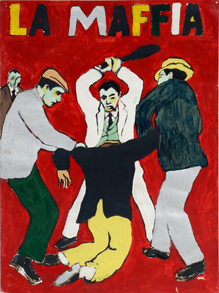
Coleen Fitzgibbon. La Maffia, 1980.
Everybody wanted to do the TSS, it seemed there was no one in Colab against doing “THE TIMES SQUARE SHOW EXTRAVAGANZA” as Jack Smith would eventually say in Beth B & Scott B’s TSS TV ad, one of the three we created for the exhibition. We put most of Colab’s bank account into that show for the building deposit, insurance, repairs (the stairs were falling apart), paint, building the Souvenir Store and the Fashion Runway, putting signs on the outside of the building, posters, printing, sandwich boards, TV ads, and flyers. There was a little money left that went to other projects like New Cinema (Becky Johnston, Eric Mitchell, James Nares, John Lurie, and Beth B & Scott B) and Spanner Magazine (Teri Slotkin and Dick Miller’s project). We also continued to give money to the live cable shows All Color News, Potato Wolf, and Red Curtain. But most of the money went for theTimes Square Show. We had to put a deposit down to rent the building and we had to get lawyer Richard Savitsky to finish Colab’s incorporation so that we could get liability insurance. The total cost for TSS was around eight thousand dollars.
We had also gone to the New York Times for a grant; they were intrigued but eventually said no, too weird. The Beard’s Fund kicked in four thousand. We didn’t plan to have the Times Square Show but the money was coming in from NEA and NYSCA in support of more group shows, as we had used the earlier artists’ studio shows at 5 Bleecker, 591 Broadway, 93 Grand St., Jay St., and the Arcade Show to prove our ability to organize group shows in our Red Book, Green Book, and Black Book grant applications.
The way that Colab functioned, to be a member you had to attend three consecutive meetings and sign in. You needed at least two Colab members involved in each project to get funding from Colab, and then you could have as many non-Colab members as you wanted. There was always the question of whether it [the project being discussed] was open to everyone or not. That generated a lot of debate and a few ugly showdowns. But whatever the proposal, it had to have at least three people promoting it to get money and two of them had to be from Colab. Each member had a certain number of shares to vote with, which were assigned a monetary value, such as fifty dollars each, and maybe two hundred dollars per vote in the case of the larger grants. Each person could put their money into any of the projects or not. That’s how the Times Square Show happened, everyone voted their share of money into the show. It was such an obvious good choice. It was also the first and last time Colab reached out to other groups of artists (such as White Columns, Harlem Workshop, and Fashion Moda). But Colab paid for the show and controlled (as best it could) its direction.
The massage-parlor building had five floors: basement, ground floor, second floor, third floor, and fourth floor. It was a huge place and the space was sort of first come, first serve. Obviously the Colab members got to put in their ideas and art first. There was a basic organizational structure created by Colab so that there would be enough room for everyone. Usually the structure worked. A core group of Colab organized into committees to build, repair, and paint the building’s interior and to design the look and themes of each floor such as the Lobby, the Portrait Gallery, the Store, the Fashion Room, the TV Lounge, the Money Love and Death Room (originally the Sex & Death Room but that seemed a little harsh), the Stairs, etc.
The original core group included John Ahearn, as he had found the space, myself, Tom Otterness, Coleen Fitzgibbon, Andrea Callard, Ulli Rimkus, Cara Perlman, Matthew Geller, Becky Howland, Justen Ladda, Charlie Ahearn, Jane Dickson, Jody Culkin, and others. During these early discussions Tom drew the floor plans and John, along with the rest of the group, decided what was to go in the rooms and who would be responsible for them. Tom also made signs for the building advertising the show. Justen organized the basement; on the ground floor (the first floor), the Lobby was overseen by John, Andrea, and Mathew; Tom and Cara set up the Store; on the second floor Mary Lemley and Sophie VDT put together the Fashion Room and runway, John Ahearn did the Portrait Room; third floor: Coleen Fitzgibbon and Ulli Rimkus made the TV Lounge/ Leopard Room and the Money Love and Death room; fourth floor: Candice Hill-Montgomery and the Harlem Workshop group, and Mike Roddy and Josh Baer with the White Columns artists; stairways were organized by Jane and Jody. John attracted large crowds to the Lobby where he and his partner Rigoberto Torres did live plaster castings of people off the street and occasionally made castings on the sidewalk. Bobby G, Mathew Geller, and Julie Harrison made videotapes inside and outside the show, interviewing spectators; Andrea Callard, Francine Keery, Teri Slotkin, and Lisa Kahane photographed the show.
The TSS was open twenty-four hours a day for thirty days, some of us would stay overnight, some for days or weeks. Jean-Michel Basquiat wrote “Free Sex” over the doorway; later somebody else came and spray-painted over it. It was the first big show for everyone except Alex Katz and Mimi Gross; younger artists showed up like Jean-Michel, Keith Haring, and Kenny Scharf. Most of the artists from Colab, White Columns, Fashion Moda, and Harlem Workshop were in it, as well as artists we didn’t know who showed up on the doorstep with art. There were films, videos, poetry, music, and performances, many were spontaneous and the audience would get into fights over whether it was a good performance or a bad performance. We had a collectors’ night when we invited the art world cognoscenti; there was not an immediate overwhelming response. Brooke Alexander, Jeffrey Deitch, Richard Goldstein, Kim Levin, and Lucy Lippard were among those who did visit.
I know Sophie VDT and Mary Lemley organized some of the fashion shows; they did one fashion show that was really great. Mary and Sophie got clothes from the Salvation
Army, such as crinoline skirts, men’s shirts, t-shirts, and fabric, and they had buckets of house paint. As the models walked by on the “runway,” their clothes would be slapped with big gobs of paint from housepaint brushes. They had this little runway with punk rock girls and real models like Lisa Rosen and they looked great. It’s a shame we didn’t video-tape it, but that was partly because nobody knew what was going to happen next. People would just show up and you wouldn’t be prepared.
I had already spent a lot of time in the area filming and going to movies. Most of us were hanging out there way before the TSS. Some artists had already worked peripherally in the area in burlesque houses, clubs, and bars before 1980.
In Times Square during the day there were tourists, business people from the area, film labs, porn shops, camera and fake antique stores, fast food joints, burlesque houses, etc. Then at night there would be the theatre crowd and martial arts and porno movie- goers. The whole row on 42nd Street was all movie theaters and peep shows at that point. There were the pimps, hustlers, pickpockets, prostitutes, and con men. Everyone came to check out the Times Square Show twenty-four hours a day. There were some wild exchanges.
People had heard of the Times Square Show because we advertised on television and a giant Spectacolor digital board (thanks to Jane Dickson), and distributed posters, placards, and flyers all made by Colab artists. Richard Goldstein wrote about it for the Village Voice. We made three thirty-second spots to run on Channel 5 (Robert Burden/NVI and I got Colab cheap production/post and Mathew Geller got us cheap ads on Channel 5). Advertising drew a wide variety of audiences curious as to why this was billed as an art show. The few problems resulted from friction between artists over space, usually not from spectators. I remember one day being on the third floor, where Christof Kohlhofer had these beautiful spray-painted cow hides on the wall, and I saw a father and his eleven-year-old son standing there [in front of the cowhides] talking about the art and why it was art. They had come to the show because they knew some of the artists from uptown so the three of us talked about whether it was art.
Street hustlers would come in, and they would watch the performances and go, “Is that art?” No, they wouldn’t sayart, they would ask “Is that a performance? That’s what we do on the street.” It was funny, like, what is reality? Diane Torr did this one piece in which she had a rubber inflatable porno doll and was doing this performance with sex toys on it, and these pimps came in and they were like, “What are you doing with that doll? You can’t do that.” They were horrified that she was doing some sort of feminist performance with it, and they said, “This is not what you use the doll for. Just think about what the doll should be used for.” She didn’t stop the performance and I was certain a fight was going to break out as her monologue was about sexual violence. Later they walked off giggling.
Those kinds of interactions would happen all the time. People would go into the store and say, “Really, it’s only $4.99? I could buy that. Well, look at that, isn’t art supposed to be expensive?” The Store was geared for street-level art collecting at affordable prices, which was good for everyone, and it was hard to keep merchandise on the shelves.
We thought Times Square was a great place to make and show art because there were so many different people. The space was huge compared to our previous shows and we got to invite as many disenfranchised artists as the building could hold. Basically it was open to anyone. It was sort of like taking all your cards and throwing them up in the air to see where they would fall. I don’t think anyone in Colab could have conceived of what the real thing was going to be like.
The diversity of artists and audience reflected NYC at that moment. We were interested in engaging the New Yorkers we didn’t usually cross paths with. I had gone to Times Square at night to see martial arts movies and had filmed interviews with hustlers during the day, but had not spent a whole twenty-four hours in Times Square until the show. To be there all the time was a great experience. When we were doing cable TV shows we would have live callers, but only a few people would phone in and say, “What are you doing? That’s so weird.” Seeing art in Times Square gave everyone a perspective that was wildly different than when the audience was just us and the art world. The graffiti artists were already used to public audiences, but this gave them a chance to experience a non-hostile response and it was sort of the reverse for the rest of us. Not hostile but not immediately accepting that this was Art. The audience was really important to most of the artists; it was suddenly a very big public, which Colab had never had before.
John and Rigoberto, by doing the live casting at TSS, brought in a whole group of kids from the South Bronx where Rigoberto lived and started out working with John casting at Fashion Moda. Most of the people from Times Square were afraid to volunteer for plaster casting; they were instinctually suspicious so John and Rigoberto’s models were usually people they knew from the Bronx and Colab. The castings on the sidewalk drew big crowds and a lot of excitement.
Other art in the show I remember (there was so much) was Justen Ladda’s perspective-man drawing in the basement, Cara Perlman’s large portrait paintings, Dick Miller’s Man Killed by Air Conditioner, Kiki Smith’s store items (such as the bloody hand ashtray), Tom Otterness’ half-skeleton half-man sculpture, Christy Rupp’s rat sculptures, Jane Dickson’s portraits on plastic bags, David Hammons’ broken Night Train bottles, Robin Winters’ plaster Colab portraits, Peter Fend’s War Room, Jane Sherry and Aline Mayer’s women artifacts and whore fashions, Becky Howland’s Love Canal Potatoes, Candice Hill-Montgomery’s lynching photo installation, Charlie Ahearn’s 3 Card Monte poster, Jamie Summers’ salt crystals, Keith Haring and Kenny Scharf’s refrigerator with tiny toy dinosaurs, Fred Hampton’s bed by Candice Hill-Montgomery, David Wells’ James Brown collaboration, Jenny Holzer’s Manifesto posters, Andrea Callard’s large watercolor paintings of the prehistoric Ailanthus plants.
As far as my work in the show, I had done the poster of the Gun Plate and Dollar with Robin Winters as X&Y in Holland; we put in a painted red original in the show and also reproduced it as wallpaper in the Money Love and Death Room where I also put in the painting La Maffia (a nod to Colab),a series of six drawings of riot squad police, six type-set newspaper paintings of financial disasters such as Fighting Over Jobs, Carter At Economic Summit,Buy Gold & Silver. There were my Daily News Headlines and several cartoon drawings including Man with Watch,Madame Curie Discovers Plutonium, Man Wears Barrel, Skull in Riot Helmet,and others. In the TV Lounge we set up televisions that played continually, and I showed LES (a documentary of the lost Wall Street tribe of Manhattma), Rich/Poor (with Robin Winters), Stripper, Daily News,and Time Magazine. I had shot some of my filmLES in Times Square and Robin Winters and I had shot Rich/Poor (as X&Y) all over Manhattan, in which we interviewed people on the street about what they thought of the rich and poor. I also made a film, Stripper,with Christa Maiwald about an older woman in a burlesque performance. Time Magazine and Daily News were shot cover to cover and were text film/videos.
As mentioned before, New York had been in a state of economic collapse since the sixties. The Bronx, Harlem, and the Lower East Side had been burned out. As artists moved in during the Colab years, we gentrified our neighborhoods. Police action, fires, drugs, and guns prompted me, as well as many other young artists, to meditate on the violence in which we, and the financial system, were complicit.
After the Times Square Show I began phasing out of Colab; it had been three years since its formation, and I was finding it hard to work with forty to sixty people on a constant basis, make art, and hold down a full-time job to pay the rent. I was in the Colab show in Washington DC, and in Brooke Alexander’s Colab show in the early eighties, before drifting off.
I started to freelance in film and television because working as a housepainter, typesetter, office secretary, Census taker, and experimental filmmaker was not working for me, or my bank account. One of my first jobs after TSS was working for Charlie Ahearn on Wild Style, thegraffiti and rap movie he made with Fab 5 Freddy Brathwaite. I went to work for CNN and Nightly Business Report doing camera and sound, and later, when I became a producer for film and television, all that experience organizing Colab came in handy. I like everyone I know from Colab and consider them family. These last seven years I have started making art and experimental videos and documentaries again, lecturing and showing in the US, Europe, and Asia.
I think it’s great that there is interest again in Colab and that you are revisiting the Times Square Show at Hunter College; several of us have been in Colab-related historic shows: NYU’s Grey Art Gallery Downtown; MoMA’sListening to Music; Subliminal Projects Gallery, LA, Art, Access & Decay,and Printed Matter’s Colab show. It seems Colab is momentarily timely again. Thanks for letting me put my two cents in…
As told to Shawna Cooper, August 17, 2011
Published: Cooper, Shawna and Karli Wurzelbacher, ed., Times Square Show Revisited: Accounts of the Landmark 1980 Exhibition. Hunter College. (NYC, 2011-12) 32-34 and at http://www.timessquareshowrevisited.com/accounts/coleen-fitzgibbon.html.
Coleen Fitzgibbon (b. 1950)
Coleen Fitzgibbon studied at the School of the Art Institute of Chicago from 1971 to 1973 and participated in the Whitney Independent Study Program from 1973 to 1974. Throughout the 1970s she exhibited her experimental films at New York City venues including Anthology Film Archives, Artists Space, and Collective for Living Cinema, in addition to showing in Belgium, Brussels, and London. She formed the collaborative X&Y with Robin Winters in 1976, and participated in the collective The Offices of Fend, Fitzgibbon, Holzer, Nadin, Prince and Winters in 1979. Fitzgibbon served as Vice President of Colab from 1979 to 1980 and as President from 1980 to 1981. Additional information is available at https://www.coleenfitzgibbon.com/.

